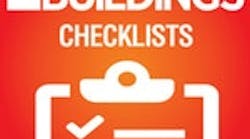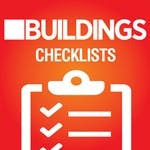The majority of commercial and industrial buildings are constructed with a concrete substrate laid over prepared soil, called slab-on-grade.
Floor covering manufacturers, whether producers of tile, wood, carpet or high-performance floor coatings, publish the maximum allowable moisture content of the concrete over which their flooring products can be installed, based on results of various ASTM test methods.
Floor moisture and moisture vapor can be cause for concern, whether the slab is newly poured or many decades old and regardless of location. Concrete science is still evolving. While the industry doesn’t have all the answers, it can be said that moisture issues in concrete floors tend to arise from one of two sources:
1. The concrete mix itself, in the event the slab is insufficiently cured or is otherwise holding moisture
2. The soil under a slab-on-grade, in the event of an improperly functioning vapor barrier
Water is an important component of any concrete mix. Newly poured concrete, given enough time, will eventually release sufficient moisture during the curing process to proceed with building construction and floor covering or a resinous floor coating system installation.
Moisture Still Present
Unfortunately, a concrete surface can easily give a false impression of being dry enough despite containing moisture well above the allowable limits. That is because even once the slab has cured, it’s never completely free of moisture.
Concrete is porous by nature and, even though the moisture near the surface of the concrete evaporates as it cures, moisture from below the concrete or within the concrete will tend to osmotically migrate up through the concrete capillaries, to escape through the path of least resistance. This process is referred to as moisture vapor transmission (MVT).
[Related: Eliminate Fall Claims By 90 Percent with this Adhesive-Backed Mat]
Moisture vapor can be measured in terms of concrete relative humidity (RH) or in terms of the rate at which the vapor is moving through the concrete. Flooring manufacturers’ suggested test methods and limits should be adhered to for best outcomes.
In the event that test results exceed the recommended moisture limits, some manufacturers offer effective MVT control solutions for use with their flooring products.
Dangers of Moisture Vapor Transmission
Some of the potential flooring issues that can result from excessive moisture vapor transmission are:
-
Delamination or bonding failure of a floor covering due to the highly alkaline liquids that can condensate underneath
-
Cracking or bubbling of a floor covering or resinous floor coating system
-
Development of uneven walking surfaces, creating slip-and-fall hazards
-
Reduced lifespan of the flooring material; damaged aesthetics
-
Invalidation of floor covering warranty, depending on MVT limits
-
Eventual deterioration and crumbling of the concrete substrate
-
Development of mold or pathogen growth either on top of the concrete slab or beneath the flooring material
Repair and remediation of concrete floor moisture conditions can be costly, and may include:
-
Removal and disposal of damaged floor covering
-
Replacement of flooring, using MVT mitigating systems
-
Mold inspection, remediation throughout the facility; certification of eradication
-
Replacement of concrete slab
Excessive concrete floor MVT can lead to more frequent, expensive repairs than anticipated, requiring production downtime and potential loss of revenue.
[Related: Top 5 Envelope Failures and Water Leaking Solutions]
Recognizing the Signs of Concrete Moisture Issues
The earlier any problems are noticed, the sooner you can act and help mitigate adverse outcomes. Vigilance and regular monitoring of the floor condition is critical.
Remember, your flooring can look fine, yet still be in the early stages of developing moisture issues.
Observable Signs to Look For
When inspecting your flooring for MVT, ask yourself:
-
Are there any damp spots on the floor or areas where you can see darker discoloration?
-
If your flooring is tile or other material that required the use of an adhesive and/or grout during installation, do you notice any loose pieces or see any signs of delamination?
-
Can you observe any cracking, bubbling, lifting or peeling of the floor surface?
-
Is there any white residue coating the floor, indicating alkali/salt deposited by condensed moisture vapor?
-
Do you see any black stains on the floor and/or walls? Is there a musty or mildew odor in the room or in any particular area?
If you answer yes to any of these questions, you may want to consider moisture vapor testing. There are several techniques and tests available to do it yourself or hire a professional.
When to Test for Moisture in a Concrete Slab
In an ideal world, every slab would be tested for moisture prior to the installation of a floor covering.
In terms of new construction, the slab should be tested after it has cured and prior to the installation of a floor covering. If excessive moisture is present, it needs to be addressed. If left to fester, it will cause problems over time, which can lead to delamination and require a complete re-installation, etc.
BUILDINGS Checklist
Preventive Maintenance
Preserve the integrity of your roofing, lighting, HVAC and plumbing with this preventive checklist. Get yours here >>
For those slabs with a pre-existing floor covering, an extra step is involved to test for moisture: The floor covering must be removed. If there are any mortars, grouts or adhesives, they must be removed and ground down to expose a clean section of concrete. Only then can you test properly for moisture using the following test methods.
3 Tests to Check for Moisture in Concrete Slabs
1. Concrete Moisture Test
One of the simplest, most economical test methods for determining whether there may be moisture in concrete is the ASTM D 4263 Concrete Moisture Test. Duct tape an 18-inch square piece of plastic onto the exposed concrete and leave it for 16 hours.
Condensed moisture accumulation under the plastic at 16 hours can indicate a problem.
2. Calcium Chloride Test
Another test is the Calcium Chloride Test (ASTM F 1869), available as a kit. By comparing the weight of the calcium chloride before and after the test time (60 to 72 hours), it indicates not just whether moisture is present, but the quantity and rate of moisture vapor travelling upwards through the slab.
Kits typically measure the moisture in the top ½ inch or ¾ inch of the concrete slab.
3. Relative Humidity Testing
Relative Humidity Testing (ASTM F2170) of the slab is done via special moisture probes embedded in the concrete substrate. The most advanced and comprehensive of the three methods, this test measures the presence and quantity of moisture throughout the depth of the slab.
Once you know whether there is a moisture control problem, consult a professional flooring contractor who specializes in moisture mitigation.
Optimal MVT Flooring Solutions
Among the many commercial, industrial and institutional floor covering options on the market, today’s resinous floor coatings offer some excellent options to help facility owners avoid floor moisture issues.
Manufacturers of quality epoxy and urethane systems offer a variety of long-lasting moisture control flooring solutions to meet the aesthetic and performance expectations of nearly every facility.
About the Author:
Kendall Youngworth is a senior marketing specialist at Tennant Coatings. She has more than 10 years of experience assisting clients across many industries in the selection and installation of optimal concrete flooring for their facilities.
Tennant Coatings of Minneapolis is a leader in flooring experience, knowledge and expertise.
Two handpicked articles to read next:



